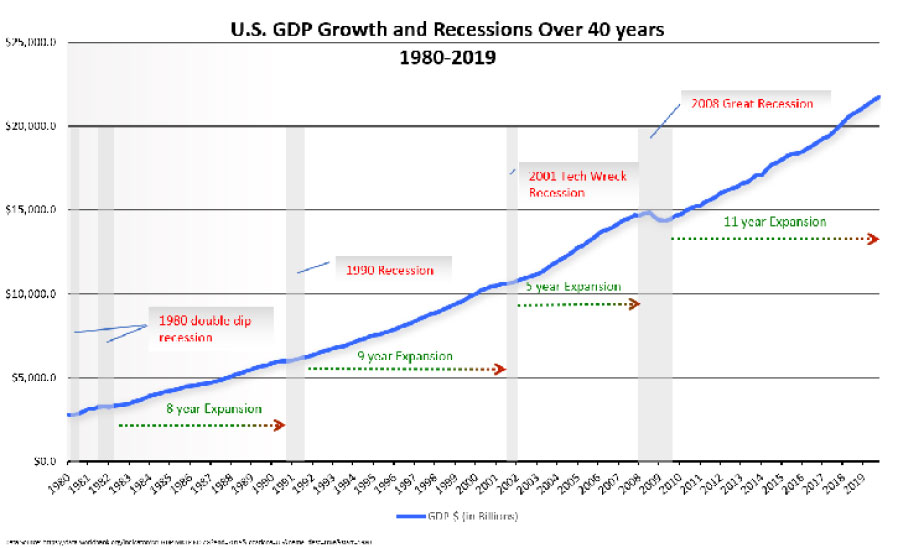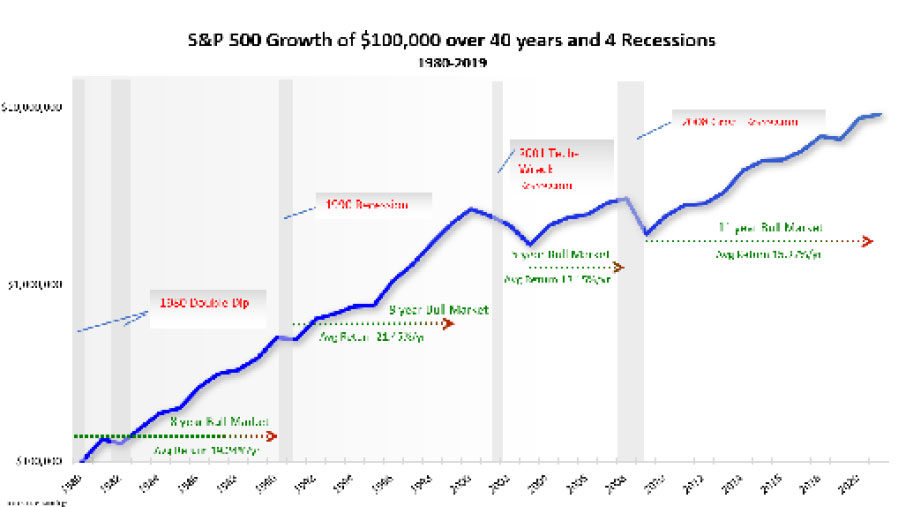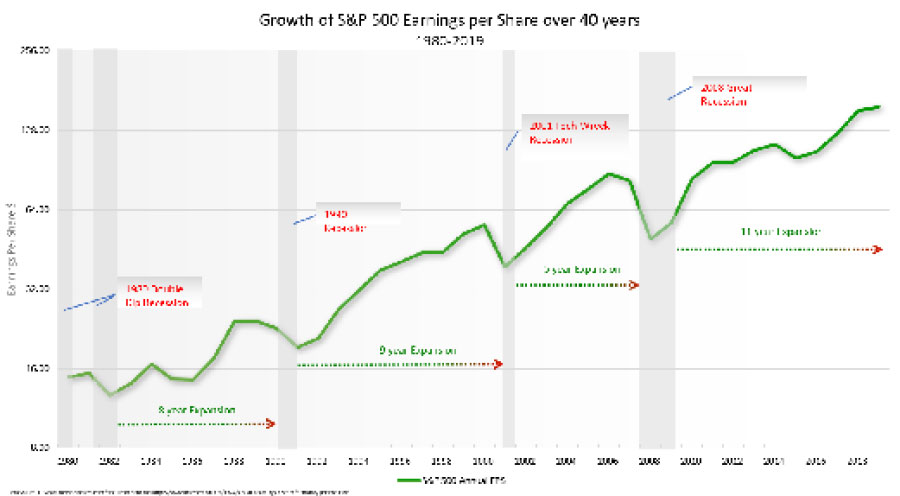The 2020 U.S. Presidential Election - Does Your Portfolio Care?
Craig Pluta
CFP® CERTIFIED FINANCIAL PLANNER™
CRPC® Chartered Retirement Planning Counselor
As the 2020 presidential election nears, we find ourselves answering the same questions that crop up in each election cycle. Namely, what effect will this have on the stock market and my portfolio and should I move to the sidelines. Although that’s a perfectly good question to ask, my answer is quite different than what politicians would answer. The stock market, or your investments, do not really react to the President or the Presidential cycle. The stock market reacts to two important factors. The first is the growth of the US economy, better known as the economic cycle, and the second is earnings per share of the companies in the stock market. Those two items are linked. Although it is a common misconception to believe that the US President has power and sway over everything, the evidence would point to quite a different conclusion. Clients who have known me for a long time are accustomed to hearing this important tenet: “If you view your portfolio through the prism of politics, you’ll make all sorts of mistakes” this was true back 25 years ago when I first pointed it out and it is equally true today, as it will be tomorrow.
If you view your portfolio through the prism of politics, you’ll make all sorts of mistakes
In reality, as opposed to the political world, the economy runs as an economic cycle. Just as summer leads to fall and fall leads to winter, so also do bull markets move to late stage and late stage leads to recession. But just as winter yields to summer, recessions yield to bull markets. It has always amazed me with such a needed focus on wealth creation and portfolio construction that few people pay attention to the economic cycle as if it’s irrelevant, when in reality it’s the primary thing we need to pay attention to. Or as Sir John Templeton so famously remarked, “the four most dangerous words in the entire investment community are; this time is different.” It’s never different, it’s just a cycle. So lets look at that cycle so that we understand it, and then overlay Presidential terms on top of it to see if it matters.
The Economic Cycle
The economic cycle is pretty simple. It fluctuates between growth of an economy followed by a slight retraction known as a recession. You will also notice that the stock market follows that same pattern which is not a coinci-dence. If you look at the long-term return of the stock market it should be noted that it does not resemble any-thing near a straight line. In fact, it goes through periods where it is up, up, up and then either stalls or comes back a little bit before going up, up, up again. The result is a rather jagged line with two things happening: the highs keep getting higher and the lows keep getting higher. That is the nature of the stock market and will always be so. Getting used to that and understanding it’s nature will be your biggest ally in life and allow you the magic of com-pounding which Albert Einstein remarked was one of the great wonders of the world.
If you look at the chart below one of the things that should stand out is that bull markets, which represent the growth of the economy, are far longer than bear markets, which represent the recessions. In fact they’re very lopsided. Let’s look at a 40 year period from 1980 to 2020. That span of time represents the average person’s working career. In that timeframe there have been four major bull markets and four recessions. The average bull market lasted about 8.25 years and the average recession lasted approximately 1.125 years.
Economies run, the way economies run. There is no Democratic economy versus a Republican economy
By any objective measurement, I would say that those odds are pretty well in your favor. More importantly, economies and stock markets develop momentum. It’s like a large locomotive starting out at the station. Even though the locomotive has the ability to go 70 miles an hour it is certainly not doing that from the very beginning. It builds up steam, pushes hard and then builds up enough momentum to get to its 70 mile an hour speed. But just as it took that locomotive some time to get to 70 miles an hour it now has momentum and slowing it down is very difficult. The economy works in the same manner. Once momentum is built up in an economy it stays running for quite some time.
Which brings me to my second tenet which is, “economies run the way economies run”. There is no Democratic economy versus a Republican economy. When an economy runs into trouble and ushers in a recessionary period, everyone does everything possible to get it back on track. At that moment there are no politics or parties because the essence of the country is its economy. Or as an old World War II expression points out “there are no atheists in foxholes”.
In the most recent bull market spanning from 2009 to 2020, there was a constant refrain of worry about the fact that the bull market had lasted 11 years, which was the longest in US history. The concern was that if we use history as a guide we were due for a recessionary period. In March of 2020 the coronavirus became a worldwide phenomenon and indeed marked the end of that 11 year bull market. The recessionary period that follows becomes the reset that we have seen time and time again. In the second half of 2020 or the beginning of 2021, whichever the case may be, will likely be marked as the beginning of a new bull market. Will this bull market be one that lasts eight years or will it be equal to the previous one which lasted 11 years or something altogether different?
...in life we will be exposed to only four or five Bull marketsI certainly don’t know, nor do I need to know, or even care. The differences are academic and not really worthy of our contemplation. What I do know is this: when you look at bull markets, the gains are incredibly impressive and empowering. The reason that I use the word empowering here is because the gains that we receive in the bull markets are what allow us to do all the things in life that we dream about. It is said that in life we will be exposed to only four or five bull markets. To waste, ignore or boycott any one of them due to fear or a lack of understanding becomes a personally destabilizing economic event and has the power to limit our future. It is also worth noting that the first bull market you experience has the least impact as you have very little money at stake, and the last bull market has the greatest impact because the power of compounding on a large sum of money produces a large dollar return.
The S&P 500 index is comprised of approximately 500 widely held stocks that is generally considered representative of the U.S. stock market. It is unmanaged and cannot be invested into directly.
Past performance is no guarantee of future results. This is a hypothetical example for illustration purpose only and does not represent an actual investment. Actual investor results will vary.
Corporate Earnings
Now let’s turn our attention to corporate earnings. It should come as no surprise that earnings are directly related to the stock market since what we are willing to pay for a stock depends largely on it’s current earnings (profits) and what we expect them to be in the future. This shows up in a measurement called the P/E ratio. The Price/Earning ratio is basically what you are willing to pay for every dollar of profit the company earns. Time honored tradition says that we will pay somewhere between 15-18 times the company’s profits to own a share of stock. If a company earns $1/share, we are generally willing to pay between $15 and $18 to own one share of that stock. If a company grows very slowly then we may not wish to pay as much and conversely if it is a fast growing company we may be willing to pay a bit more. If we find ourselves in a recessionary period, then it would stand to reason that both current profits and the future profits are likely to be down. And as you would guess, that ordinarily will make the stock go down as well. Conversely, if gross domestic product (GDP) is rising and earnings are going up in the company, it stands to reason that the company will be worth more especially if the future prospects look good and we are anticipating even better future earnings. This is why the earnings per share (EPS) follow both the GDP and Stock Market charts. In fact, the stock market is simply the reflection of all the individual companies earning prospects viewed today.
Bull Market Presidents
Election years are fraught with claims and debates over who is better for the economy and markets, which is why it’s worth our time to look at which Presidents presided over the past bull markets.
As you can see from the chart below, each of the bull markets, except for one, spanned across two presidential periods. And half the time, spanned across opposing political parties. Since the electorate in the U.S. is split nearly 50/50, it means that in the beginning of any given bull market approximately half of the public believes that the country is going in the wrong direction and the economy is going to Hell-in-a-handbasket and will take the stock market with it. Then, when it switches and the opposing political party takes over, which almost always happens as the political pendulum swings to and fro with regularity, the former group who thought that things were going to Hell-in-a-handbasket before, are suddenly ecstatic now that they are in power and believe that the market and the economy will do well, while the newly disenfranchised stretch their necks to view Armageddon on the horizon. And so goes the world of politics with each political party purposely fanning the flames to get their way and gain power. This is not new nor is it uniquely American since we can see this all the way back to the Roman Empire. The world of politics is divisive by nature and nasty in rhetoric, which is perhaps why a political observer once remarked that the word politics can be better understood by looking at the latin roots of poly- meaning: many, and tics- meaning: blood sucking creatures.

Partisan investing
So let’s just say I’ve got this all wrong. Maybe you say, “I don’t care what those numbers say I think there’s a difference”. Then clearly investing in a partisan way would be the wisest choice. It is not difficult to track that theory down and see if it works. What we did here is apply the investment returns taking place only by investing when a Democrat is in the White House and compare that to the investment returns while being invested only when a Republican was in office. Then finally, what the returns would be if we remained invested through both Democratic and Republican administrations in the White House. The findings are quite startling.
When you look at the graph below the first thing you’ll notice is that Republican only administrations and Democratic only administrations are like two horses racing each other. From 1980 to 1998 it appears that the Republicans have the lead. Then from 1998 until 2009 the two parties are neck n neck. From 2009 to 2018 the Democratic only investing pulls ahead but the gap starts narrowing in 2019 as the Republican horse starts catching up. All in all, it looks like a very good close horse race. Then you look at the green line and notice that there is no circumstance where single party investing gives you an advantage over dual party investing. In fact, it’s quite sobering to see that dual party investing nets the investor approximately 6.6x the amount of money.
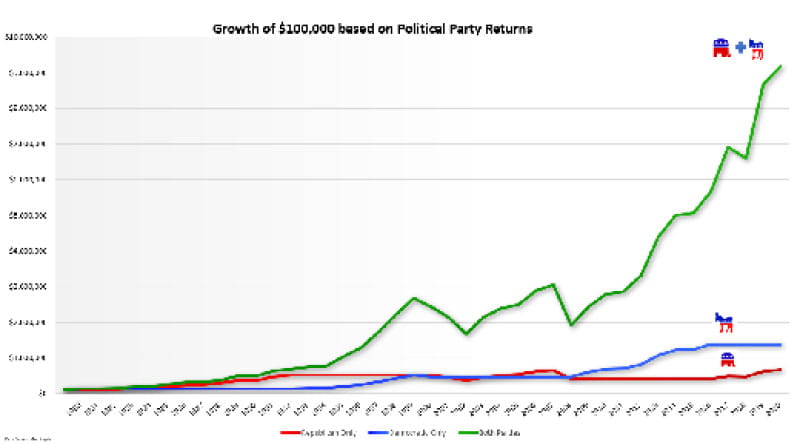
What this graph so brilliantly points out, is that the greatest risk for the investor is to confuse politics and investments. And remember my #1 tenet, “if you look at the portfolio through the prism of politics, you’ll make all sorts of mistakes”. In looking at the graph above I would label that a “big dollar” mistake.
Which leads me to my 3rd and final tenet: “it’s not just the things we don’t know that hurt us, it’s the things we think we know, that just ain’t so”
I am an avid believer in being politically active, and I applaud everyone who is passionate about their politics no matter what side they find themselves. But we run perilous risks when we extrapolate what we “feel” onto areas that do not react to our feelings. Suddenly our fears are driving our actions and we are no longer in control. Perhaps worse than that, the fear occupies our mind and time, robbing us of better things to do and think about.
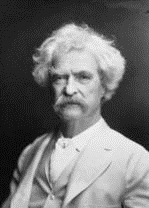
But perhaps Mark Twain summed it all up best, when he said;
“I’ve had a lot of worries in my life, most of which never happened.”
Conclusion
Although it’s easy to see why in a hot political environment we would get swept up in the emotions and convince ourselves that this election is the only election that matters and that the worlds fate and economies all hang in the balance, but it’s just a dystopian tale. In reality, the world out there is a pretty amazing place and the progress over the past 100 years probably rivals all other progress since the beginning of mankind.
Your portfolio and investment plan are intended to ride through the storms and still deliver you to the original goal. Don’t let those “things we know, that just ain’t so” rain on your parade. Talk with your financial advisor, review where you intend to go and stick with the plan that gives you the best chance at arriving at your intended destination.

Craig Pluta is a CFP® CERTIFIED FINANCIAL PLANNER™, CRPC® Chartered Retirement Planning Counselor, Financial PodCaster and President of Alliance Wealth Management Milwaukee, inc. He was named on Forbes Best-In-State Wealth Advisors in 2020 and is a member of the Chairmans Council at Raymond James Financial Services. You can hear more from Craig by tuning in to his monthly PodCast Wealth Vision 20/20, available worldwide on Spotify or by visiting his website at www.AwmMil.com.
You can also reach him at Craig.Pluta@raymondjames.com
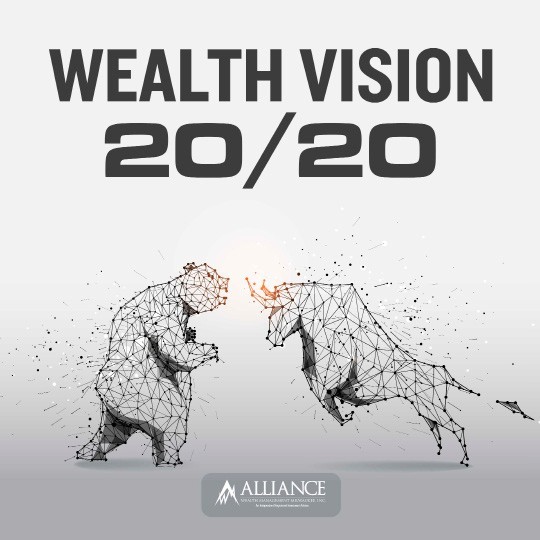
Any opinions are those of Craig Pluta and not necessarily those of Raymond James. This material is being provided for informational purposes only and is not a complete description, nor is it a recommendation. There is no guarantee that these statements, opinions or forecasts provided herein will prove to be correct. Investing involves risk and you may incur a profit or a loss regardless of strategy selected. Prior to making an investment decision, please consult with your financial advisor about your individual situation.
Raymond James Chairman’s Council membership is based on prior fiscal year production. Re-qualification is required annually. The ranking may not be representative of any one client’s experience, is not an endorsement, and is not indicative of advisors future performance. No fee is paid in exchange for this award/rating.
The Forbes ranking of Best-In-State Wealth Advisors, developed by SHOOK Research, is based on an algorithm of qualitative criteria, mostly gained through telephone and in-person due diligence interviews, and quantitative data. Those advisors that are considered have a minimum of seven years of experience, and the algorithm weights factors like revenue trends, assets under management, compliance records, industry experience and those that encompass best practices in their practices and approach to working with clients. Portfolio performance is not a criteria due to varying client objectives and lack of audited data. Out of approximately 32,000 nominations, more than 4,000 advisors received the award. This ranking is not indicative of advisor's future performance, is not an endorsement, and may not be representative of individual clients' experience. Neither Raymond James nor any of its Financial Advisors or RIA firms pay a fee in exchange for this award/rating. Raymond James is not affiliated with Forbes or Shook Research, LLC. Please visit https://www.forbes.com/best-in-state-wealth-advisors for more info.


